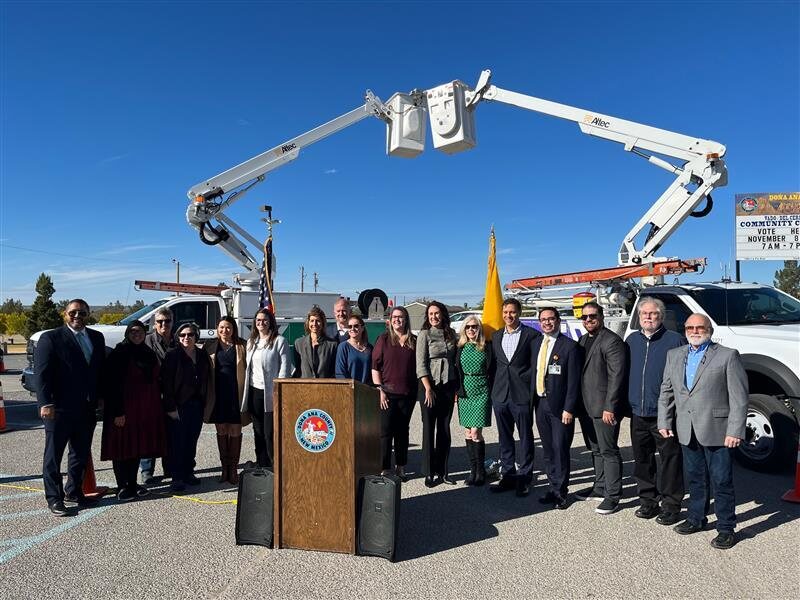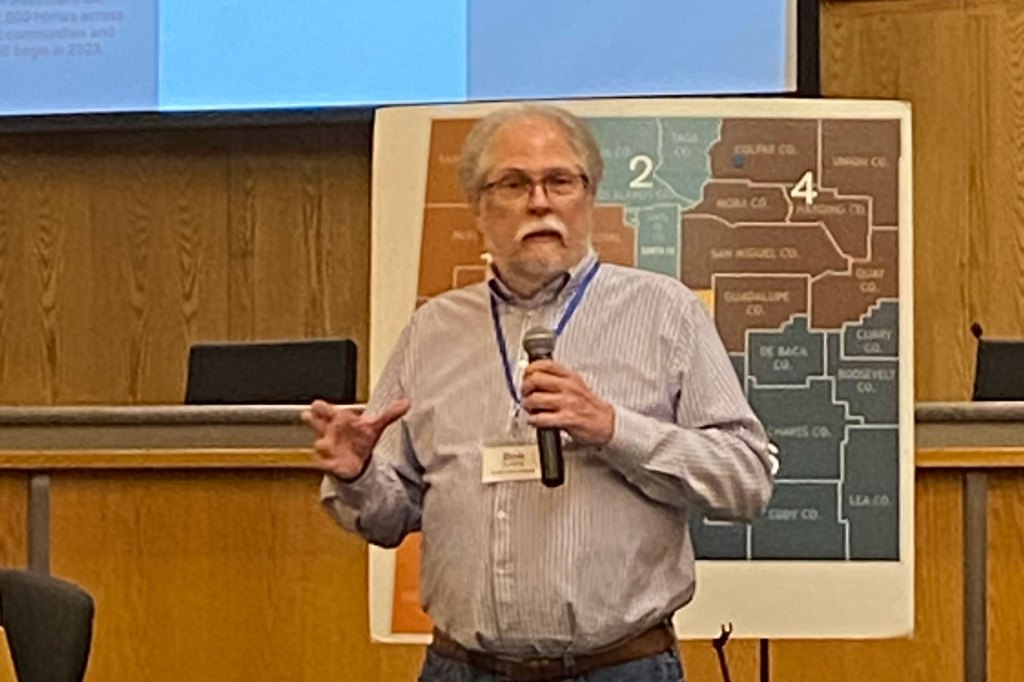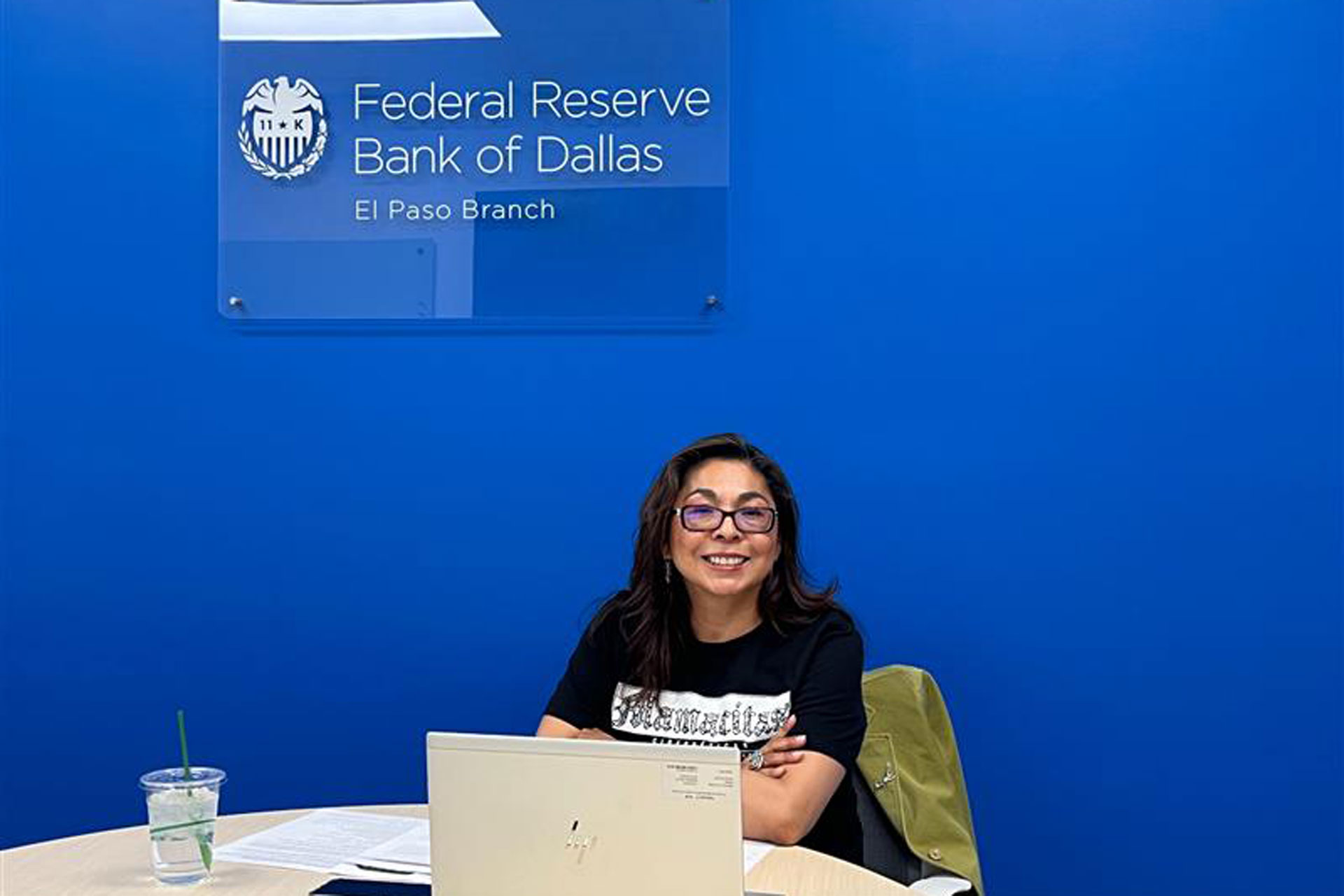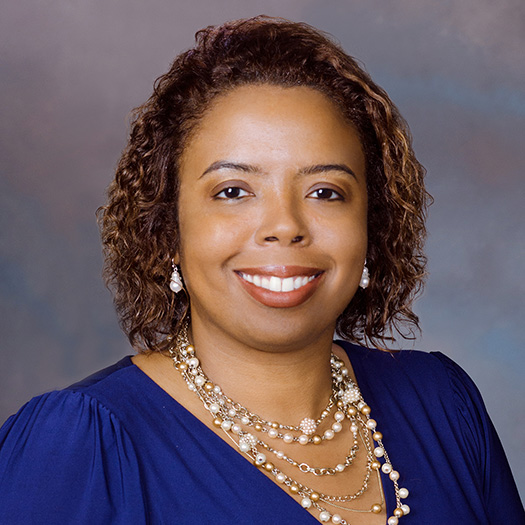RURAL AMERICA: A Treasure of ASSETS
November 30, 2023
Bridging the rural digital literacy and connectivity divide in new mexico
By Jennie Blizzard, Fed Communities

Photo: Diana Alba Soular/ SNMJC
During the pandemic, Maria Chaparro didn’t expect her time as an HIV-prevention coordinator who conducted community outreach in the 1990s to contribute to reliable internet access and digital literacy efforts in rural Doña Ana County, New Mexico. But that’s exactly what happened. Maria used her community outreach experience and founded the Mamacítas Cibernéticas (Cybernetic Mamas). During the pandemic, they hosted group sessions and conducted one-on-one interviews to get the community’s input about their wants and needs for digital inclusion and literacy.
Meanwhile, during that time, Bob Bunting, the county’s director of information technology, saw the urgent need for reliable internet services for households, businesses, and schools as quarantines and social distancing became the norm. To address this need, Bob brought together representatives from the county, economic development, education, and community organizations to form the Doña Ana Broadband Group. The group’s goal was to discover ways to strengthen internet connectivity in the region.
Promotoras (community health workers), who were experienced in community outreach, knocked on thousands of residents’ doors during the pandemic to gather input about broadband needs.

The Dallas Fed selected Doña Ana Broadband to participate in its Advancing Digital Inclusion initiative. The initiative works with several regional groups as they develop cost-effective, long-term solutions to expand access to broadband. The initiative’s goal is to help communities achieve a sustainable digital inclusion strategy that connects all residents to the internet.
In 2022, Doña Ana Broadband Group merged with Digital El Paso, a coalition with similar goals, to form Borderplex Connect, a regional group of partners that supports and provides internet access and digital skills training to underserved communities in far West Texas and southern New Mexico. The coalition has successfully secured millions of dollars to fund digital inclusion efforts and was the first to get state dollars for infrastructure.
Maria and Bob share how authentic community input, coupled with intentional collaboration, is advancing digital inclusion in this rural region.
Why is digital inclusion important for rural communities?
Maria: I live 13 miles away from the closest library and 10 miles away from the nearest large retailer. I have reliable transportation. My family was able to order online and pick up from the stores during the pandemic shutdown. But many families didn’t have access to the internet or didn’t know how to apply it in their everyday lives. Since the pandemic, many services have shifted “to online.” But many rural communities couldn’t and still can’t make this transition as the internet has now become a basic need.
Bob: I had tried to start a broadband group before the pandemic. But the pandemic really spurred interest for both the county and the stakeholders. I started Doña Ana Broadband to bring together community stakeholders from various organizations. It was important to make broadband internet more accessible in our community (schools, government agencies, nonprofits, etc.).
What is the biggest challenge in getting broadband to rural communities?
Bob: In parts of Doña Ana County, it’s expensive to build what’s needed to provide broadband services to rural areas. It’s a huge financial investment for providers since rural areas have fewer residents. There’s little financial incentive for broadband providers to create this infrastructure in less densely populated areas without significant grant funding. In other areas of the county, the primary barriers are digital literacy, especially among seniors, followed by lack of access to quality devices that our constituents can afford. These challenges need to be addressed if we want to succeed in digital inclusion.
Why is the assessment important and how will it be used?
Maria: The information is timely and reflects the true barriers the community experiences. But it also provides practical solutions to overcome digital literacy barriers. Local stakeholders can use it as a blueprint to develop or expand digital navigation services. I’m confident that assessments related to access, affordability, sustainable development/infrastructure, etc. and that our efforts which focus on digital equity and inclusion will resonate with other communities. We want these recommendations to be included in the plan.

I’m confident that assessments related to access, affordability, sustainable development/infrastructure, etc. are being conducted and that our efforts which focus on digital equity and inclusion will resonate with other communities and be included in the plan.
Maria Chaparro
What are the essentials for developing a comprehensive broadband action plan?
Maria: There are four key things:
- Know and describe all the barriers to broadband. Include the community in the planning process and ask what they consider as the biggest barriers to using the internet. In our case, it was not a lack of access but a lack of computer skills. Let the need lead your broadband action plan.
- Ask the community for solutions and document these. We conducted focus groups to document both barriers and solutions and developed the topic guide on digital literacy because that was the greatest need expressed.
- Identify relevant stakeholders in the region. They can provide insight into the barriers and solutions and document that perspective. For example, I asked the librarians at the City of Sunland Park Community Library about digital navigation services done there and they said about 90% of the help they give the community is related to internet use. Once you have identified these needs and potential solutions, describe the resources (or lack thereof) that currently respond to those. The librarians suggested that Sunland Park hire a full-time digital navigator at the library because of the demand for that service.
- Capture the specific barriers encountered by each region—rural, tribal, urban, frontier. New Mexico is a large state in terms of geography. The comprehensive plan must address these diverse nuances and honor that activities in our tribal lands will differ from counties along the US-Mexico border. All broadband expansion efforts should not be based only on urban areas. Otherwise, the disparities will continue.
Doña Ana was the first community in the state of New Mexico to receive funds for digital inclusion: how did you prepare for that? What was that process like?
Bob: We worked with the state from the beginning, and they helped us substantially with our survey. This, plus the great support we received from the Dallas Fed’s Advancing Digital Inclusion initiative, provided us with strong support for a feasibility study and freed up funds to let us invest further in engineering and planning efforts. Working collaboratively with others has been key.
How are you working to ensure your state/county has access to available funding?
Bob: We’re working with our State Office of Broadband Access and Expansion (OBAE) to be sure we understand their requirements and that any potential projects we would put forward dovetails well with their overall plans for the Broadband, Equity, Access, and Deployment (BEAD) Program. BEAD will eventually provide over $42 billion to expand high-speed internet access in all US states and territories. We’re also working with other entities to identify potential BEAD projects, partners for such projects, and the necessary resources to begin creating grant proposals. These other entities currently include a broadband engineering firm, county-contracted grant writers, internet service providers (ISPs), and other governmental and nonprofit entities in southern New Mexico that may have an interest in cross-jurisdictional projects.
Are there any innovative funding approaches that you find promising?
Bob: We’re using a public-private partnership that reduces installation costs and allows for future expansion of internet access without additional construction costs. This allows the county to connect fire stations, community centers and other county buildings, while also enabling the ISP to provide services to residents and businesses in the area. In return for sharing the same installation path and the county’s investment, the ISP will maintain both the county and their own infrastructure at no cost. This provides more funds upfront to the ISP for installing the backbone. While it also helps the county, we are not equipped to maintain our own fiber over the long distances required by the project. This arrangement also allows the county to invest in the project while still maintaining our commitments to allow for competition.
What’s the biggest barrier to this work that this initiative has overcome and how have you all worked through it?
Bob: Finding ways to organize our efforts as our group grew. We initially created subgroups and assigned tasks and separate meetings for them between the main group’s meetings. We also collaborated with an El Paso broadband group to learn from them and share what we were doing. While this was helpful, success still depended on the willingness of others to volunteer their time and skills for these efforts. To address this, we formed a non-profit organization, Borderplex Connect, that focuses on digital inclusion for both El Paso and Doña Ana County. The goal is for Borderplex Connect to have dedicated staff that can keep our projects well managed and moving forward and also help us identify new funding opportunities and projects.
Maria: The reimbursement process for costs related to providing community incentives could have been smoother. Thanks to my husband, I was able to buy supplies and gift cards for community incentives. We used these to help recruit our focus group. I don’t think we would have been able to do our needs assessment if I had not been able to provide incentives. We need to resolve how to access funds in a timely manner.
What has been the most successful aspect of the project and what contributed to its success?
Bob: Our community survey stands out in my mind as a success. We gathered more than 3,000 responses, including more than 1,500 respondents without internet access. We wouldn’t have gotten so many responses from the community without the strong door-to-door effort that was led by promotoras (community health workers) during the pandemic. They are in contact daily with our constituents and have earned their trust. This positioned them perfectly to successfully administer the survey. Our survey is also available in both English and Spanish to ensure broad reach in our bilingual community. The promotoras are bilingual, so there were no language barriers.
The survey, report and an interactive map of the results are all available.

Doña Ana County, New Mexico
Demographics in this largely rural county shape the community’s approach to expanding broadband access. These factors affect economic inclusion overall.

No internet service
Nearly 1 in 4 households in Doña Ana County, New Mexico have no internet subscription at all. In the US. as a whole, about 1 in 7 households lack internet service.

Sources: Doña Ana Community Broadband Survey; HighSpeedInternet.com (2022).
Slow internet speeds
For most households with internet in Doña Ana County, New Mexico, download speeds are substandard and well below the US average of 119 Mbps.* Speeds for over a third don’t meet the federal minimum for broadband.
Source: Federal Reserve Bank of Dallas blog Community broadband survey paves way for expanding digital access in southern New Mexico
How can government and policy work best together in bringing broadband access to rural areas?
Bob: I advocate for local government to do what it can to encourage broadband development and make it an attractive investment for ISPs, while keeping local government out of the broadband business. This does not include strategic investment in some infrastructure where an ISP might be interested in leasing or purchasing that infrastructure from the county. With careful planning, policies like “dig-once” and public-private partnerships can be implemented and accelerate infrastructure needs.
Also, I believe it’s important to invest across a spectrum of infrastructure and services needed to be truly effective. Building infrastructure is important (e.g., putting fiber in the ground, building towers, etc.). But we also have to ensure we address digital literacy, affordable devices, services, and other needs to meet the community where they are.
What role does literacy training play in the work you do? How do you tailor such programs to meet the needs of the communities you serve?
Maria: We were funded to conduct the Comprehensive Needs Assessment (CNA). It’ll be up to the stakeholders to assess their service delivery programs and adapt or tailor them to address the needs expressed in the CNA. Mamacítas Cibernéticas can help with evaluation efforts to see if services are truly meeting the communities’ needs.
What’s the most important lesson you would share with rural localities embarking on this work?
Maria: Engaging the community is not done through a smartphone or from one’s office. You can’t just send an email or a text and expect the community to eagerly respond. Form a community engagement team with different levels of knowledge and skillsets that will approach and engage community members with respect.
Bob: This isn’t a project any of us can afford to give up or move on from. This is a long-term problem for many communities. Start as soon as you can and keep at it once you begin! It takes time and setbacks are part of the process. So don’t give up when you run into problems or disagreements. Also, find others in your local community, surrounding area, and state who are passionate about broadband. Be sure to include them. Collaboration is essential to avoid duplicating efforts. Vet ideas for projects and share the work to make faster progress.

I would love to collaborate with others who are working on broadband in their communities to share ideas, learn, increase our leverage in dealing with Internet Service Providers and ultimately improve our approach to broadband!
Bob Bunting
Related Federal Reserve resources
- Investing in Rural Prosperity: “Bringing Broadband to Rural America: The Role for Philanthropy”
- “Disconnected: Seven Lessons on Fixing the Digital Divide”
- Dallas Fed’s Digital Inclusion Efforts
- “Closing the digital divide: A framework for meeting CRA obligations”
- Rural Spotlight: Bringing Broadband to Maryland’s Eastern Shore
- “Beyond Broadband: Device Access and Digital Equity in Pennsylvania”
- “Plugged In: Tools, Skills, and Inclusion in an Increasingly Digital World”
- Rural Community Action Assembly: Broadband Deployment and Community Readiness
- Rural Community Action Assembly: Digital Equity for Infrastructure, Technology, and Skills
- “Increasing Broadband Access and Affordability: How the Affordable Connectivity Program Can Bridge the Digital Divide”



